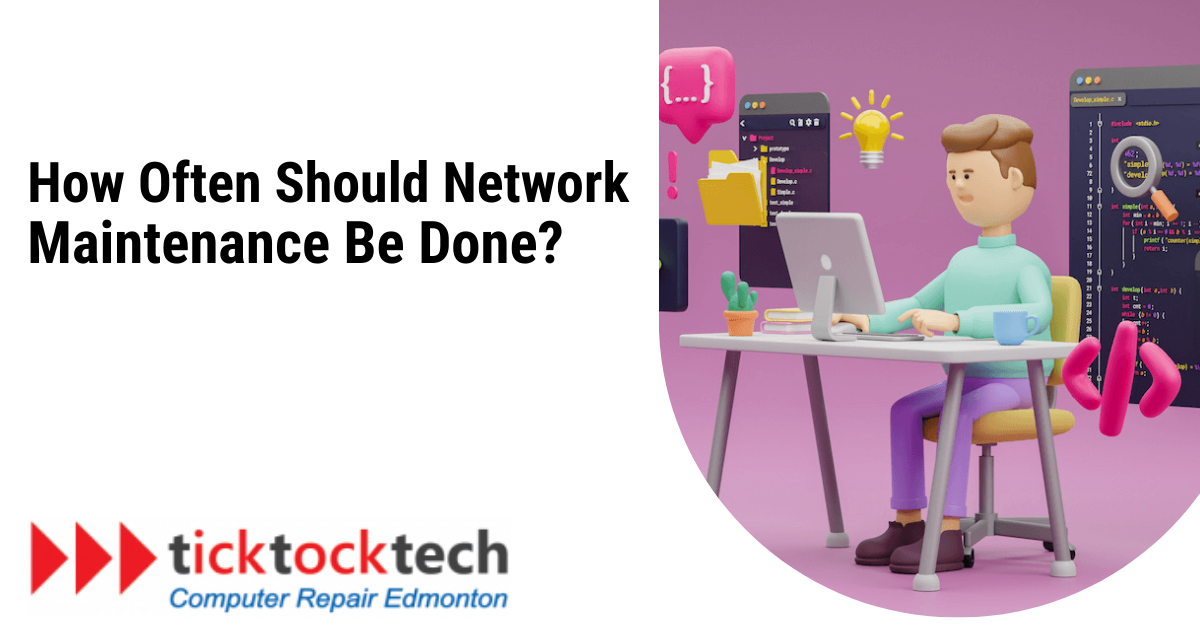Aside from the hardware and software, the network is a crucial part of IT and computer technology as a whole. When you use your computer devices for work or business, it is compulsory to have a working network. I need not explain how a network gives access to the transfer or transmission of data and access to the internet, but there is more to that, especially for server-based networks. Network sources such as servers allow for the storage of vast amounts of data, freeing up RAM and allowing individual PCs to function better. These network devices, just like computers and other IT infrastructures, need to be properly maintained. This maintenance ensures the smooth running of the network and most especially the security of the network.
There are different maintenance measures to ensure this. However, several factors, including the size of the network, the complexity of the infrastructure, specific maintenance measures, and the organization’s special demands, determine how often you perform them.These maintenances could be weekly, monthly, Quarterly, and Yearly. Let’s have a look at which maintenance is done at each of the time intervals.
1. Daily Maintenance
There are crucial aspects of the network hardware and the connected devices that need to be examined daily. Regular network maintenance includes backing up important data, keeping an eye on performance, and scanning for software updates. Updating your devices and network is crucial if you want to defend against known vulnerabilities. Regular maintenance guarantees data security and aids in problem-solving
Performance Diagnosis
In network maintenance, daily performance diagnostic entails monitoring and analyzing the network’s performance to find any flaws or problems that may be affecting its dependability, speed, or security. To ensure dependable, fast, and secure network operations, this comprises network traffic analysis, bandwidth consumption analysis, network latency monitoring, packet loss monitoring, network congestion monitoring, and network security monitoring.
Daily Backup
In network maintenance, daily backup is creating a copy of key data and systems to defend against data loss or corruption. Backing up vital files, databases, and system settings and storing the backups in a secure location are all part of this. Daily backups guarantee business continuity in the event of an unexpected occurrence or data corruption.

Related: Importance of Data Backup in 2024
Regular monitoring of connected devices
It is important to verify the list of devices that are linked to your Wi-Fi network regularly through the settings of your router. Ensure that you can identify all of the devices that are connected. Immediately investigate any devices that are unknown to you if you come across any. An unidentified device on your network may be an indication that unwanted access has been gained.
2. Weekly Network Maintenance
Routine cleaning, monitoring of usage patterns, and identification of potential security threats are all components of weekly network maintenance. It is of the utmost importance to identify whatever potential security risks may exist and to take preventative steps. The removal of useless data is another benefit of performing weekly maintenance on the network, which helps to ensure that it continues to function correctly.
Scanning for security threats
In weekly network maintenance, scanning for security threats entails monitoring network traffic, systems, and applications for potential vulnerabilities and malicious activity. This involves detecting and removing malware, viruses, and other dangers with security technologies. Weekly scanning aids in the maintenance of a secure network environment and the prevention of any data breaches.
Routine Cleaning
Routine cleaning during weekly network maintenance includes emptying the recycle bin, deleting temporary data, and deleting unnecessary data. This increases efficiency, reduces the likelihood of security concerns, and keeps the network nice and orderly. Routine cleaning can be accomplished using software tools and built-in utilities.
3. Monthly Network Maintenance
In the course of performing monthly network maintenance, it is necessary to perform tasks such as updating antivirus software and signatures, conducting comprehensive scans, and reviewing network logs. This identifies any potential issues and contributes to the implementation of safeguards against the most recent dangers. Another advantage of undertaking maintenance monthly is that it allows for the examination and upgrading of network security rules and procedures.
Software Updates
Updating the software on network devices periodically improves the network’s security, which is susceptible to intrusions from malware and cybercriminals. For network devices to be safe, software updates must be applied regularly. Software such as firmware, operating systems, network protocols, firewalls, virtual private network (VPN) software, antivirus software, intrusion detection and prevention systems, SSL/TLS, and network management software can all be updated to address vulnerabilities and enhance performance.
See Also: Top 10 Importance of Regular Software Updates in 2024
Comprehensive scans
Comprehensive scans are performed as part of monthly network maintenance and involve a thorough examination of all network hardware, software, and applications for defects or vulnerabilities. This includes using antivirus network diagnostic software to check for software upgrades and configuration issues, as well as scanning for malware, viruses, and other security threats. Thorough scans are performed using specific tools and methodologies to ensure network performance and security.
Related: Top 5 tools for Network Vulnerability Scanning
Reviewing network logs
This includes scanning log files for odd behavior, looking for problems or warnings, and analyzing log data to detect trends or patterns. Examining network logs enables network managers to spot and handle issues before they become serious concerns.

4. Quarterly Network Maintenance
A quarterly network maintenance process includes several different activities, including assessments and updates of the network infrastructure, in-depth studies, and exercises to practice disaster recovery. This ensures the protection of essential data and keeps the network functioning and up to date. During the quarterly maintenance, businesses can actively develop and evaluate disaster recovery plans.
Disaster Recovery
Businesses need a solid IT disaster recovery plan to avoid digital calamities. First, examine all risks, including natural disasters, cyberattacks, and human factors. Regular security assessments and employee training reduce threats. Establish a crisis team, event detection, and recovery processes in a clear reaction plan. Create a backup and restoration system and check it often. Encryption, upgrades, and explicit standards strengthen cybersecurity.
Related: Business recovery plans Vs. Disaster Recovery
5. Annual Network Maintenance
Performing extensive network audits, developing disaster recovery plans, and reviewing and updating network security policies and procedures are all part of annual network maintenance. Regular reviews and updates are necessary to keep security policies up-to-date and functional. Identifying potential issues and creating a strategy to solve them are further benefits of annual maintenance.
Develop network security plans and policy
The organization needs a robust security plan to prevent network intrusions. This plan should encompass password management, access control, incident response, and other security issues. It is typically done by IT, legal, and compliance customizing a firm security plan >>> This plan will follow industry standards like the NIST Cybersecurity Framework. >>> To stay relevant, the plan will be evaluated and changed annually or as needed.
Annual reviews and updates
Review and update the network security plan often to stay effective. The network security review should discover gaps and deploy additional security controls as needed. The IT department will evaluate the network security plan annually, and then fix security issues uncovered during the exam. Experts will assess and replace current security methods if needed.
Identifying potential issues and how to solve them
This entails anticipating network security threats and devising solutions. This may include identifying and addressing vulnerabilities and creating incident response strategies for security incidents. The IT staff will utilize vulnerability scanning and penetration testing to find network flaws. The IT department will also reduce vulnerabilities and apply new security rules to fix difficulties.
6. Automated Network Maintenance
Automating routine network maintenance chores such as backups, software upgrades, and performance monitoring through tools and software constitutes the process known as automated network maintenance (ANM). Your information technology personnel will be able to focus on more difficult issues if you do this, which will assist in ensuring that your network is always working at its highest possible performance.
How Often Should Network Maintenance Be Done?
How often you manage your network infrastructure could be daily, weekly, monthly, or yearly, but the regularity depends on the maintenance measure itself. For instance, checking for available software updates should be done at least weekly. You should conduct security scanning and audits at least weekly or, at the latest, monthly, and you should review and update security policies and plans annually. The time interval between these maintenance measures also depends on the extent of your organization’s operation. The more operations you perform with your network infrastructures, the more regularly your maintenance culture should be, for mainly security and avoiding vulnerability.
Conclusion
Regular network maintenance is critical for assuring IT infrastructure security and performance. Daily actions like as data backup, performance monitoring, and update scanning all contribute to data security and problem resolution. Weekly maintenance includes screening for security concerns, cleaning routinely, and tracking usage patterns. Monthly operations include software updates, thorough scans, and network log examinations. Quarterly maintenance involves disaster recovery drills, while annual chores include detailed audits, security plan development, and policy reviews. Automation solutions can streamline routine tasks. Factors such as network size and complexity determine maintenance frequency, with increased security and reduced susceptibility requiring more frequent maintenance for more operations.

